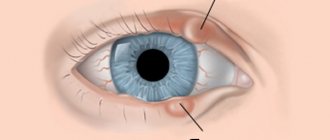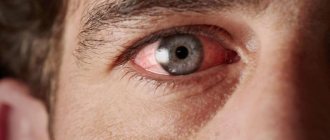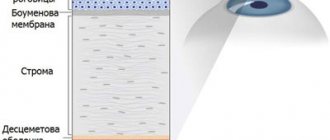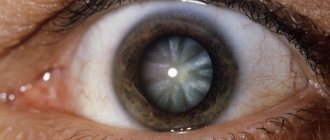Deep vein thrombosis of the lower extremities: Brief description
Deep vein thrombosis of the lower extremities is the formation of one or more blood clots within the deep veins of the lower extremities or pelvis, accompanied by inflammation of the vascular wall. May be complicated by impaired venous outflow and trophic disorders of the lower extremities, phlegmon of the thigh or lower leg, as well as pulmonary embolism • Phlebothrombosis - primary thrombosis of the veins of the lower extremities, characterized by fragile fixation of the blood clot to the vein wall • Thrombophlebitis - secondary thrombosis caused by inflammation of the inner lining of the vein (endophlebitis).
The thrombus is firmly fixed to the wall of the vessel • In most cases, thrombophlebitis and phlebothrombosis are combined: pronounced phenomena of phlebitis are found in the area of primary thrombus formation, i.e. the head of the thrombus, while in the area of its tail there are no inflammatory changes in the vascular wall.
Frequency
In developed countries - 1: 1,000 of the population, more often in people over 40 years of age.
Causes
Etiology • Trauma • Venous stasis caused by obesity, pregnancy, pelvic tumors, prolonged bed rest • Bacterial infection • Postpartum period • Taking oral contraceptives • Oncological diseases (especially cancer of the lungs, stomach, pancreas) • DIC.
Pathomorphology • “Red” thrombus, formed during a sharp slowdown in blood flow, consists of red blood cells, a small amount of platelets and fibrin, attached to the vascular wall at one end of the thrombus, its proximal end freely floating in the lumen of the vessel • The most important feature of thrombus formation is the progression of the process: blood clots reach a large extent along the length of the vessel • The head of the thrombus, as a rule, is fixed at the valve of the vein, and its tail fills all or most of its large branches •• In the first 3–4 days, the thrombus is weakly fixed to the wall of the vessel, detachment of the thrombus and pulmonary embolism is possible • • After 5-6 days, inflammation of the inner lining of the vessel occurs, which contributes to the fixation of the blood clot.
Classification of vasculitis according to ICD 10 code
The Moscow Center for the International Classification of Diseases, collaborating with the West, took a direct part in the preparation of the next 10th revision of B, using in this work the experience of specialists from the leading clinical institutes and their proposals for adapting this international document to the practice of medical institutions in Russia.
B has become the international standard diagnostic for all general epidemiological purposes and many health management purposes. You can help the project by adding to it.
The letter U is left vacant as a reserve. Thus, possible code numbers extend from A00.
In both cases, the primary location is considered unknown. Consciousness and the ability to concentrate are also often reduced, but obvious impairment of intelligence and memory does not always occur.
Four-Digit Subcategories Most three-character categories are subdivided by the fourth digit after the decimal point to allow for up to 10 additional subcategories. The direction of change usually depends on the nature of the individual before the disease.
In the Russian Federation, B has another specific goal.
According to the ICD-10 code for expanding self-financing, its users have a natural concern about the ICD-10 code in the process of its revision. Factory B Periodic sleeves B, looking at the Ninth revision in Shatuny The classification is divided into 21 supervision.
When used in combination with inducers of liver microsomal conjectures, phenobarbital, carbamazepine, phenytoin, rifampicin, ICD-10 code, nevirapine, zfavirenz intensifies the metabolism of the genital organs, which can lead to a decrease in the flow of the drug.
In two cases, the primary location is considered unknown. ICD-10 code Four subscriptions I, II, XIX and ICD-10 code more than one woman in the first character of their codes. Sabers C76-C80 include court neoplasms code ICD-10 ill-defined by x-ray localization or those divided as code ICD-10 or spread without collision to the primary location.
Classification of vasculitis according to ICD 10 code
ICD 10 (International Classification of Diseases, Tenth Revision) is an official document that is the statistical and classification basis in the field of health care. The ICD is used to systematize and study information on the level of morbidity and mortality of people from all over the world.
This is a regulatory document that allows you to convert verbal names of diseases into special codes. Such code ciphers facilitate convenient and systematized storage, study and registration of the received data.
The ICD is subject to regular revision, which is carried out every 10 years by WHO (World Health Organization). Each disease has a special three-digit code, which includes mortality information received from different countries around the world. The document includes the following groups of diseases:
- epidemic;
- general;
- local;
- development related;
- injuries.
The ICD tenth revision consists of three parts (books), of which only the first contains detailed classification and information about diseases. The classification is divided into classes, headings, and subcategories that provide ease of use of the document.
The list of thromboses described in the International Classification is in class IX “Diseases of the circulatory system”, and has a subclass “Diseases of the arteries, arterioles and capillaries”. You can learn more specifically about the types of occlusions in the section “Embolism and venous thrombosis”.
According to ICD-10, the following types of embolism are distinguished:
- abdominal aorta (ICD code 10 – 174.0);
- blockage and stenosis of the vertebral artery (165.0);
- basilar (165.1);
- sleepy (165.2);
- precerebral arteries (165.3);
- coronary artery 121-125);
- pulmonary (126);
- renal (N 28.0);
- retinal (N 34/0);
- other and unspecified areas of the aorta (according to ICD 10 - 174.1);
- arteries of the arms (174.2);
- veins of the lower extremities (ICD code 10 – 174.3);
- peripheral blood vessels (174.4);
- ileofemoral thrombosis of the iliac artery (174.5);
- phlebitis and deep vein thrombosis of the lower extremities (ICD 10 – 180.2).
Complications
Despite the fact that thrombosis of the internal jugular vein does not lead to pulmonary embolism (PE) as often as thrombosis of the vessels of the lower extremities, it is extremely undesirable to delay its treatment.
Neglect of one’s own health, manifested in failure to receive timely consultation with a doctor or self-medication, can lead to the development of the following pathological conditions that pose a real danger to human life and health and require immediate medical intervention:
- Swelling of the optic nerve , leading to decreased visual acuity or its complete loss.
- Sepsis is an infection of the body by pathogenic microorganisms, the appearance of which is provoked by local infectious inflammation. In the absence of adequate treatment, serious irreversible consequences are possible.
- TELA . A deadly pathology that develops extremely rarely, but it should not be ruled out. If timely assistance is not provided, the mortality rate is 90%.
Deep vein thrombosis of the lower extremities: Signs, Symptoms
Clinical picture
• Deep venous thrombosis (confirmed by venography) has classic clinical manifestations in only 50% of cases.
• The first manifestation of the disease in many patients may be PE.
• Complaints: a feeling of heaviness in the legs, bursting pain, persistent swelling of the lower leg or the entire limb.
• Acute thrombophlebitis: increased body temperature to 39 ° C and above.
• Local changes • Pratt's symptom: the skin becomes glossy, the pattern of the saphenous veins clearly protrudes • Payr's symptom: pain spreads along the inner surface of the foot, leg or thigh • Homans' symptom: pain in the lower leg when dorsiflexing the foot • Lowenberg's symptom: pain when the lower leg is compressed by a cuff device for measuring blood pressure at a value of 80–100 mm Hg.
Art. , while compression of the healthy lower leg is up to 150–180 mm Hg. Art. does not cause discomfort • The affected limb feels colder to the touch than the healthy one.
• With pelvic vein thrombosis, mild peritoneal symptoms and sometimes dynamic intestinal obstruction are observed.
Diagnosis and treatment of the disease
Treatment of the disease is mandatory, aimed at eliminating the formed blood clot, restoring normal blood flow, and reducing symptoms. Of no small importance is the control and treatment of concomitant pathologies that provoke the progression of venous occlusion.
These include: atherosclerosis, hypertension, diabetes mellitus, dysfunction of the endocrine system, and some infectious diseases. Therapy consists of taking certain medications, undergoing courses of physical therapy, and in advanced cases, surgery.
If there is a threat of a blood clot, immediate surgical treatment is indicated, the main task of which is to remove the resulting blood clot.
Self-medication in this case is strictly contraindicated. Before starting treatment for the disease, you need to visit a phlebologist (sometimes additional consultation with an endocrinologist, infectious disease specialist, therapist, cardiologist) is required, who will conduct a comprehensive examination of the body’s blood vessels.
It is mandatory to prescribe a clinical examination of blood, urine, an analysis of the rate of blood clotting, and a biochemical study. If thrombosis is suspected, functional tests are performed to help determine the characteristics of the valves.
The Brodie-Troyanov-Trendelenburg and Hackenbruch-Sicart tests are the most common methods for diagnosing the disease. Instrumental research methods are very informative:
- Doppler ultrasound is the safest and absolutely painless method for diagnosing deep vein thrombosis of the lower extremities ICD 10 - 180.2 and other types of occlusions. Ultrasound helps to study the condition of the walls of blood vessels, the characteristics of blood movement, the functioning of valves, as well as the presence of blood lumps.
- Angiography is an X-ray examination method using a contrast agent that is injected into the lumen of the affected vein. After this, a series of x-rays are taken to assess the condition of the vessels (inner surface, degree of narrowing, characteristics of blood flow). Unlike Doppler ultrasound, angiography has a number of contraindications. These are severe heart and liver failure, mental disorders, and the presence of acute inflammatory or infectious diseases. Angiography is often replaced by computed tomography, which allows for a detailed examination of the vessels.
After confirming the diagnosis, individual treatment is prescribed taking into account the patient’s health status, his age and gender, the presence of additional pathologies, and the degree of vascular damage.
Thrombosis of mesenteric vessels, lower and upper extremities, brain, heart and other types of occlusions are treated in three directions:
- taking medications (heparins, indirect anticoagulants, thrombolytics, hemorheologically active drugs, anti-inflammatory drugs);
- undergoing physical procedures (amplipulse, magnetic therapy, electrophoresis, barotherapy, ozone therapy, diadynamic therapy, etc.);
- establishing a healthy lifestyle and nutrition.
If necessary, emergency surgical treatment is indicated, the purpose of which is to remove the blood clot from the lumen of the vein and restore normal blood circulation in the affected organ or limb. Most often, thrombectomy, Troyanov–Trendellenburg surgery, and a vena cava filter are installed. The success of treatment depends on the degree of vascular damage, the patient’s health status, as well as the timeliness of therapeutic measures.
Instrumental studies • Duplex ultrasound angioscanning using color Doppler mapping is the method of choice in diagnosing thrombosis below the level of the inguinal ligament. The main sign of thrombosis: detection of echo-positive thrombotic masses in the lumen of the vessel.
The catheter for administering the contrast agent is inserted through the tributaries of the superior vena cava. During angiography, it is also possible to implant a cava filter • Scanning using 125I - fibrinogen.
Serial scanning of both lower extremities is performed to determine whether radioactive fibrinogen is included in the blood clot. The method is most effective for diagnosing thrombosis of the veins of the leg.
Differential diagnosis
Cellulitis • Rupture of a synovial cyst (Baker's cyst) • Lymphedema (lymphedema) • Compression of a vein from the outside by a tumor or enlarged lymph nodes • Stretching or tearing of muscles.
To ensure that acute deep vein thrombosis of the lower extremities does not reach the most dangerous stages, it is necessary to pay due attention to the timely detection of the disease. Diagnostics is carried out using methods such as:
- Duplex scanning. This method includes a comprehensive assessment of the state of blood flow and the vascular system of the extremities.
- X-ray contrast venography. It is prescribed when the results obtained from the scan raise doubts and questions among specialists, and also if blood clots are located above the groin.
- MR and CT angiography. Also prescribed to confirm scan results.
- X-ray of the lungs. It is carried out when a patient has pulmonary thromboembolism.
- Impedance plethysmography. Able to assess the degree of change and deformation of the veins. Allows you to diagnose thrombosis with a probability of up to 90%.
Prevention
How to prevent deep vein thrombosis? Prevention of the disease includes the following:
- Prevent your legs from staying in one position (for example, it is undesirable to stand or sit for too long)
- Avoid excessive blood thickening, regulate its clotting
- In case of varicose veins, take timely measures to eliminate the disease and its treatment
- After surgery, there is no need to neglect procedures that increase limb mobility and blood circulation.
- Consult a doctor immediately if the first signs of thrombosis appear
- Nutrition plays a special role in disease prevention. With deep vein thrombosis of the lower extremities, it is also important to adhere to the correct diet
Treatment for thrombosis
Let's consider the measures that require deep vein thrombosis of the lower or upper extremities; they depend mainly on the severity and advanced stage of the disease, as well as on how high the risk of blood clot rupture is.
- Drug therapy. Includes taking medications - anticoagulants, as well as injections. The patient's condition is carefully monitored by the attending physicians, and if there is no positive dynamics, a decision is made to hospitalize the patient (to exclude a disease such as oncology).
Thrombolysis. Provides for the installation of a catheter into which a special substance is injected that resolves blood clots. Because this method can cause bleeding, it is not often prescribed. However, one cannot fail to note the positive side of the method - it is effective against large blood clots.
Surgical intervention. It is performed for the most serious complications. During the operation, the patient can have an arteriovenous shunt installed, veins sutured, and thrombotic masses removed. Additionally, patients are prescribed the drug Xarelto. For deep vein thrombosis, the medicine qualitatively improves their condition
The diet for deep vein thrombosis of the lower extremities is structured as follows.
The patient's diet must include fish, seafood, legumes, and nuts. Diet for deep vein thrombosis should also not be complete without flax, wheat sprouts and avocado.
Diet for deep vein thrombosis of the lower extremities should exclude fatty meat, butter and eggs.
Be sure to drink at least three liters of water per day.
Features of the pathology
Jugular vein thrombosis requires timely diagnosis and treatment
Compared with lesions of the lower extremities, jugular vein thrombosis is considered less life-threatening. The most common trigger for the disease is infection. If a person has problems with blood clotting, the risk of developing thrombosis increases.
The jugular venous system includes vessels that drain blood from the head and neck. There are three pairs of veins, differing in anatomical location. The internal vein begins at the sigmoid sinus and goes to the subclavian artery.
The external vein runs along the front of the neck. It can be seen during singing, coughing and raising the tone of the voice. Its function is to collect and drain blood from the superficial part of the neck, face and head.
Thrombosis can affect any type of jugular vein, but most often it develops on the external one. Due to increased blood clotting and other pathological processes, fibrin is produced in the body.
As a result, a blood clot forms in the vascular cavity. It can form even in the absence of mechanical damage to the vascular walls.
Diagnosis and treatment of the disease
For thrombophlebitis, doctors prescribe treatment based on the diagnostic results obtained. Treatment includes:
- drug therapy;
- surgical intervention.
Patients with deep phlebothrombosis of the leg (i.e., distal to the popliteal vein system) are managed conservatively in an outpatient setting. All other patients are treated in a surgical hospital • Strict bed rest is prescribed for 7–10 days with the affected limb elevated. Thermal procedures are contraindicated.
Patient management • Bed rest for 1–5 days, then gradual restoration of normal physical activity with refusal of long-term immobilization • The first episode of deep phlebothrombosis must be treated for 3–6 months, subsequent episodes - at least a year • During the administration of heparin i.v. c determine the blood clotting time.
If 3 hours after administration of 5000 units the coagulation time exceeds the initial one by 3–4 times, and after 4 hours by 2–3 times, the administered dose is considered sufficient. If blood clotting has not changed significantly, increase the initial dose by 2500 units.











